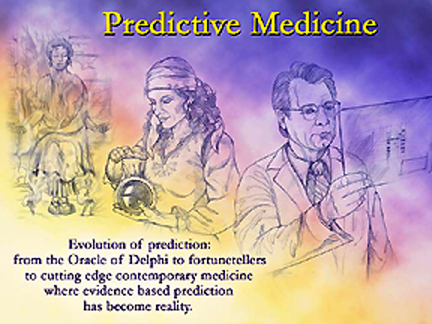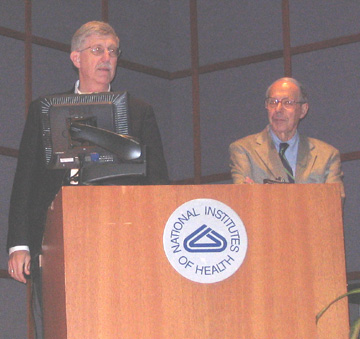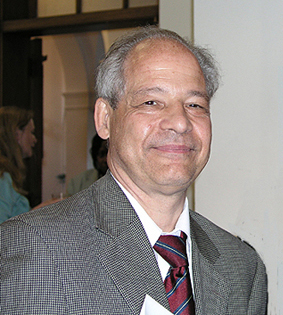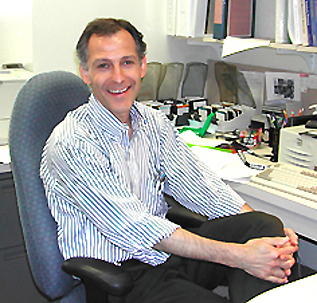
| T H E N I H C A T A L Y S T | N O V E M B E R – D E C E M B E R 2006 |
|
|
|
Research
Festival
|
by Dustin Hays |
 |
Predicting the future is not a new calling, Abner Notkins observed in opening the NIH Research Festival symposium on predictive medicine. But unlike the predictions of the oracles of antiquity or of new-age fortunetellers—based more in the realms of art or artifice—21st-century predictive medicine is based in science.
Today’s oracles, Notkins said, are clinicians who plumb the depths of patients’ DNA, RNA, proteins, autoantibodies, and the like to glean potential future health problems—with the objective of countering disease emergence before symptoms appear.
Notkins, chief of the Experimental Medicine Section, NIDCR, was among the symposium’s oracles of evidence-based predictive medicine. He focused on the role of autoantibodies in predicting autoimmune disorders.
Joining him were:
![]() NHGRI Director Francis Collins,
who described efforts to elucidate the genetic components of common disease
NHGRI Director Francis Collins,
who described efforts to elucidate the genetic components of common disease
![]() Lance
Liotta, co-director of the Center for Applied Proteomics and Molecular Medicine
at George Mason University, Fairfax, Va. (and former NCI Laboratory
of Pathology chief), who presented his research on protein-based predictors
to tailor personalized cancer therapy
Lance
Liotta, co-director of the Center for Applied Proteomics and Molecular Medicine
at George Mason University, Fairfax, Va. (and former NCI Laboratory
of Pathology chief), who presented his research on protein-based predictors
to tailor personalized cancer therapy
![]() Ezekiel Emanuel,
chair of the CC Department of Clinical
Bioethics, who tempered the momentum toward predictive medicine with some
cautionary thoughts
Ezekiel Emanuel,
chair of the CC Department of Clinical
Bioethics, who tempered the momentum toward predictive medicine with some
cautionary thoughts
Francis Collins: Genes as Predictors
With the unraveling of the human genome came the revelation that humans are amazingly similar: Roughly 99.9 percent of our DNA base pairs are identical, Collins observed, leaving the scant remaining 0.1 percent to account for our genetic variability and, thus, our varied genetic predisposition to disease.
Great progress has been made in isoating genetic disorders that have a predictable pattern of inheritance, such as cystic fibrosis, but it appears that the familial risks of more common diseases—such as heart disease and depression, which lack a predictable inheritance pattern and vary in severity among individuals—are attributable to genetic variations, mostly single nucleotide polymorphisms (SNPs), scattered among the roughly three billion base pairs in the human genome.
Early attempts to link genetic components to common diseases, Collins said, were akin to a "drunk searching for his keys under a street light—we were looking only in the places where we could see."
But now, he said, the recently completed Hap Map Project, a multinational effort involving more than 1,000 scientists, has mapped the location of SNPs throughout the human genome and "lit up the street," providing the power tools to identify weak genetic contributors to common diseases.
 |
|
Francis
Collins (left) and Abner Notkins
|
Collins cited a few early discoveries attributable to the use of Hap Map data, such as the relationship of a complement factor H gene variant to age-related macular degeneration (AMD)—a leading cause of blindness in the elderly not previously thought to have a strong genetic component. In all, three risk variants have now been identified, accounting for 74 percent of AMD risk.
Similarly, Hap Map data provided the foundation to enable isolation of risk variants for prostate cancer associated with a greater risk among African than European men—which may contribute to the higher incidence of prostate cancer among African-American men.
Collins gave the audience a sense of gene hunting using Hap Map data by profiling the FUSION study, a genome-wide association study aimed at finding weak genetic contributors to type 2 diabetes. The study is a collaboration among four partners—the Keck School of Medicine at the University of Southern California, Los Angeles; the University of Michigan School of Public Health, Ann Arbor; Finland’s National Public Health Institute; and Collins’ intramural research laboratory at NHGRI.
Using the Illumina® 317K platform, which evaluates roughly 317,000 SNPs defined by the Hap Map Project, 1,186 people with type 2 diabetes and 1,171 matched control subjects were genotyped at the NIH/Johns Hopkins’ Center for Inherited Disease Research in Baltimore to identify gene variants associated with type 2 diabetes.
Among those associations found was a previously identified gene variant called transcription factor 7-like 2 (TCF7L2). Though not conclusive on their own, when FUSION data were combined with data from a similar study conducted by the Diabetes Genetics Initiative of the Broad Institute, Cambridge, Mass., TCF7L2 had the greatest genome-wide significance for type 2 diabetes, with a combined odds ratio of 1.35.
Phase II of the FUSION study will genotype an additional 3,000 patients and controls using the top 1–3 percent of SNPs identified in Phase I.
Collins pointed out that appropriate sampling power is critical to uncover weak heritable links based on SNPs; the rarer the allele, the greater the number of cases that must be genotyped. He anticipates that the Phase II findings will uncover additional, as-of-now elusive, diabetes-susceptibility variants.
"Identifying gene variants such as TCF7L2," Collins said, "will provide the drug targets of the future for small molecules that go right to the heart of the problem instead of treating some secondary effect."
Lance Liotta:Proteins as Predictors
Genes can say a lot about an individual’s predisposition to cancer, but they cannot reveal what is happening in cells at the functional protein level, for example, in a tumor, Liotta observed.
He discussed a rationale for using tissue proteomics to subcategorize patients’ tumors based on the activated state of associated tyrosine kinases, corresponding signaling pathways, and the context of the tumor’s microenvironment. Access to this knowledge, he proposed, will allow clinicians to predict patients’ responses to various cancer treatments and to custom-tailor therapies to maximize benefits and minimize side effects.
 |
|
Lance
Liotta
|
Liotta noted that anticancer drugs that target small molecules often work only in a subset of tumors. One such drug, an epidermal growth factor receptor (EGFr) inhibitor called gefitinib, proved effective in 15 percent of nonsmall cell lung-cancer patients enrolled in a clinical trial. By some accounts, those results would constitute a failure—but for the 15 percent in whom the drug worked, it was a success, Liotta said.
He described the use of reverse-phase protein microarrays to assess the activation of signaling pathways in microdissected lung tumor cells taken by core needle biopsy.
This technique can identify which cells in a heterogeneous cell sample are activated by phosphorylation, shedding light on which pathways may be hyperactivated or suppressed. Hyperactivation of the EGF pathway is believed to contribute to 11–19 percent of non–small cell lung- cancer cases. Protein microarrays can identify patients who fall into this category who may be candidates for EGF-pathway inhibitors.
Liotta is currently collaborating with investigators at NCI and at Northeastern University in Boston to map phosphorylation sites on the EGF receptors of tumor cells. A new technology called dynamic quantitation using Fourier-transform mass spectrometry enables the investigators to examine patterns of EGFr phosphorylation over time in response to stimulation and to correlate them with interconnected pathways downstream. A prospective clinical trial to evaluate the role these patterns play in association with lung cancer is set to begin early next year.
Abner Notkins: Antibodies as Predictors
Type 1 diabetes patients begin expressing autoantibodies as early as 5–10 years before the clinical onset of disease. Early evidence suggests this phenomenon is also true of many of the 40–80 other autoimmune diseases thus far identified.
Notkins made the case for using autoantibodies as predictors of autoimmune disease and for constructing what he called the "autoantigenome," which involves the identification and characterization of all the major autoantigens in the most common human autoimmune diseases.
Notkins has been studying autoanti-gens associated with type 1 diabetes for about 10 years. His prospective studies have revealed that patients with Type 1 diabetes express autoantibodies to one or more proteins–IA-2, GAD65 (glutamic acid decarboxylase) and/or insulin—years before symptoms appear.
He said that the likelihood of developing type 1 diabetes within five years is 10 percent in the presence of one autoantibody, 50 percent in the presence of two, and 70 percent in the presence of three.
Because the three major autoantigens in type 1 diabetes are associated with vesicles—dense core or synaptic—that carry hormone and neurotransmitter, Notkins hypothesized that there are other still unrecognized autoantigens that are associated with these vesicles.
He and his colleagues have developed a selective screening approach to identify type 1 diabetes-associated autoantigens: They prepared a panel of 56 vesicle-associated proteins, starting with their gene sequences, and then screened each protein with sera from patients with type 1 diabetes and from control subjects. Both IA-2 and GAD were readily identified as autoantigens, and additional studies now entering a validation phase have revealed several new candidate autoantigens.
 |
|
Ezekiel
Emanuel
|
As it turns out, type 1 diabetes is not the only autoimmune disease in which autoantibody expression precedes symptoms, Notkins noted. Data from other laboratories indicate that this phenomenon occurs in rheumatoid arthritis, lupus, Addison’s disease, multiple sclerosis, celiac disease, and pemphigus.
Notkins outlined six uses for predictive autoantibodies: 1) to predict the likelihood of developing disease, 2) to estimate the length of the asymptomatic period, 3) to help classify autoimmune diseases, 4) to provide predictive information about disease course, severity, and complications, 5) to serve as a warning to avoid potential disease-triggering factors, and (6) to identify high-risk individuals who might be suitable candidates for therapeutic intervention trials.
The enormous value of autoantibodies as predictive indicators of autoimmune disease, Notkins suggested, warrants screening the entire proteome for autoantigens to create the human "autoantigenome." Considering the breadth of autoimmune disease, which crosses multiple organ systems, such an endeavor could best be undertaken as a trans-NIH Roadmap project, he said.
Ezekiel Emanuel: Ethical Issues
If the aspirations of predictive medicine are realized, what effects will they have on individuals and on society as a whole? Are there drawbacks to a brand of medicine that seeks to cure disease before it starts?
Yes, there are substantial caveats, Emanuel cautioned. As predictive medicine evolves, it is likely our ability to cure disease will lag behind our ability to detect it. Knowledge is not necessarily a good thing, for example, if one were told to expect a disease for which, at least currently, there is no cure. Predictive medicine, like all medicine, can pose risks to both individuals and society, he observed.
Even as established a procedure as screening mammography can carry undesirable physicial and emotional risks for individuals, Emanuel said. The consequences of a breast biopsy following an equivocal mammogram, for instance, range from lymphedema to unnecessary physical and psychological trauma in the approximately 50 percent of women whose biopsies are negative.
There are risks and harms to society as well. Of the two trillion dollars the United States spends annually on health care, only those spent on vaccines actually save money. Everything else contributes to the steadily rising cost of health care. As of yet, Emanuel noted, there has been no analysis of the cost effectiveness of predictive medicine.
The public’s somewhat ambiguous reception of predictive medicine thus far, he continued, has presented challenges to gauging its overall usefulness. He cited the discovery of BRCA1/2 mutations, which are linked to both breast and ovarian cancer, as one example. Before the advent of BRCA1/2 testing, a substantial percentage of women with a family history of breast cancer elected to have prophylactic bilateral mastectomies.
Because women willingly sought such a radical measure in an effort to ward off cancer, it was believed that a genetic test for BRCA1/2 would instill a sense of hypervigilance among women who tested positive and that they would seek monitoring interventions, such as mammography, in greater numbers.
In fact, however, when a genetic test became available, many women chose not to learn their BRCA1/2 status, and though mammography rates among those who tested positive did increase—from 49 percent to 61percent—they did not soar.
As Emanuel pointed out, "…providing predictive tests does not ensure people will adhere to monitoring and preventive interventions."
Perhaps the most pervasive and difficult to pinpoint undesired consequence of predictive medicine is captured in the irony that despite the fact that the average lifespan in the United States has increased by seven years since 1960, Americans’ perceived sense of well-being has gone down while health-related anxiety has gone up. Emanuel posed the question: "Why does predictive medicine make us feel worse?"
He suggested that "a
heightened consciousness of health might lead to greater self-scrutiny and an
amplified awareness of symptoms and feelings of illness" and that "an
increasing focus on health issues in the media might create a climate of apprehension,
insecurity, and alarm about disease." ![]()